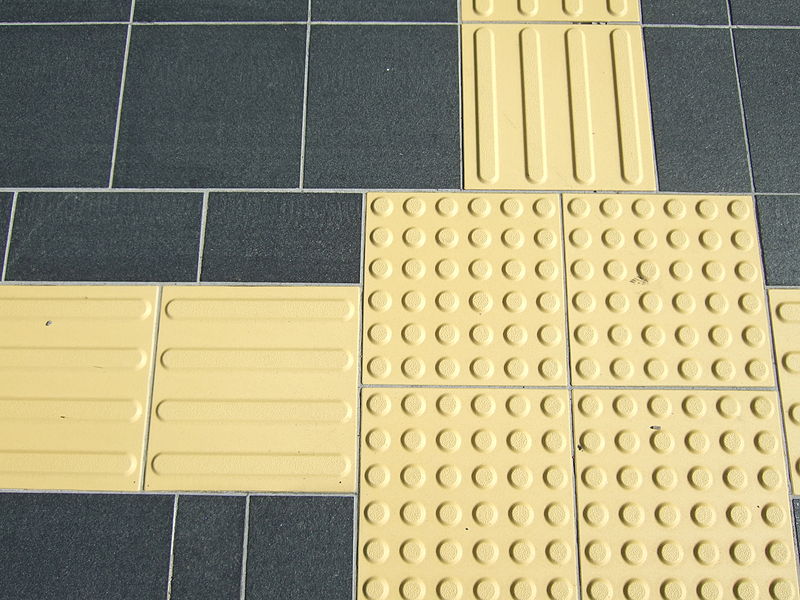









Creating an inclusive environment that caters to people of all abilities is crucial in architecture and code-compliant tactile solutions prove to be of big help. However, the commonly held notion of accessibility is limited to physical disabilities like wheelchair users. Architects often envision accessibility as incorporating ramps, wide corridors, and elevators. But disability comes in many different forms, some of which may not be visible.
Therefore, accessibility in our surroundings involves much more than just accommodating wheelchair users. For instance, incorporating tactile elements in architecture and urban design can significantly improve the navigability of space for visually impaired people. In this blog, we dive into the world of tactile paving, discussing its various forms, historical significance, and how it can be implemented to create an inclusive environment.
Tactile paving refers to textured ground surface indicators that provide cues for navigation to the visually impaired. As per the Accessibility for Ontarians with Disabilities Act or AODA guidelines, tactile paving is required at pedestrian walkways, transit platforms, parking lots, interiors of apartment buildings, office buildings, malls, any public interior spaces, and other public spaces. The raised bumps and grooves in tactile pavers allow visually impaired persons to detect important navigational signals through their canes or underfoot.
Back in 1965, a Japanese engineer named Seiichi Miyake invented tactile bricks to support his visually impaired friend. Little did he know that his invention would revolutionize the way we navigate our cities. Two years after its inception, Okayama City in western Japan became the first city to install tactile paving around the city.
Over time, it gained popularity and was widely adopted by the Japan National Railway within a decade. By 1985, it became mandatory for cities across Japan to install tactile paving. Today, the use of tactile bricks has spread beyond Japan, and they are now a common sight in cities all over the world. From Australia to the UK, the US, and Canada to many other countries, tactile paving has become an essential tool for the visually impaired to navigate their surroundings with greater ease and independence.
Tactile paving comes in a diverse range of types, each with its unique colors and markings that convey distinct meanings. Generally, these tiles are painted in bright hues to enhance visibility for partially sighted pedestrians. This is especially important as per the Americans with Disabilities Act, which mandates a color contrast of at least 70% between the tactile bricks and the surrounding pavement. In several countries, a bright yellow color is commonly used to serve this purpose.
Tactile surfaces are an absolute game-changer for architecture and urban design. They are a lifeline for visually impaired individuals, allowing them to navigate the built environment with greater ease. It's important to note that the disability is not in the person but in the barriers present in the physical space.
Incorporating tactile surfaces into architectural design is crucial for improving accessibility. Architects should actively consult the accessibility guidelines of their own country or district to ensure these surfaces are integrated effectively. By following these guidelines, architects can transform functional products into added value for architectural design.
The best part? These inclusive projects, with their attention to detail, can significantly enhance the lives of all occupants. So, if you're designing a commercial building, incorporating tactile surfaces is a small yet impactful step toward creating a more inclusive and welcoming environment.
In Canada, tactile pavers address the serious issue of limited navigability and accessibility in many city public spaces for the visually impaired. These pavers guide blind or low-vision pedestrians to detect obstacles, wayfinding paths, transit platforms, crosswalks, interiors of apartment buildings, office buildings, malls, any public interior spaces, etc. For example, tactile pavers with uniform grooved bars indicate the path to the destination, raised bumps signal a stop like an intersection, and stair landings and staggered bumps indicate the edge. This helps solve the key problems of mobility and access in Canadian cities for persons with visual disabilities.
Canada has an aging population and the number of people with age-related visual impairments is growing. At the same time, Canadian cities are encouraging active, outdoor lifestyles with more pedestrian avenues, cycling infrastructure, and public transit, interiors of apartment buildings, office buildings, malls, any public interior spaces. Tactile paving is crucial to make these active transportation routes and public spaces accessible to visually impaired residents so they can maintain active lifestyles. With increasing awareness, many Canadian cities are now retrofitting public areas with tactile paving to enable visually impaired pedestrians.
With the right solutions and standards in place, tactile paving can help Canadian cities achieve goals of inclusion, accessibility, and active living for all. Companies like Tactile Solutions are key partners in paving the way. For more information on tactile paving solutions for your city or business, contact Tactile Solutions at https://www.tactilesolution.ca/solutions. Let's make infrastructure accessible and inclusive one step at a time.
